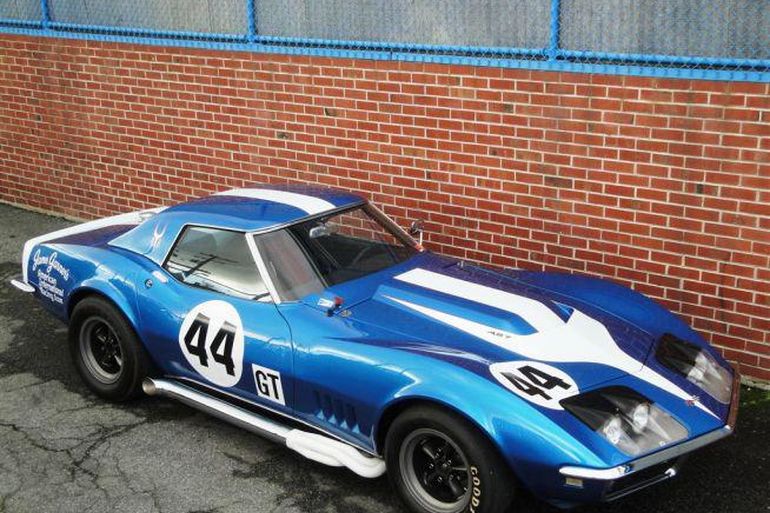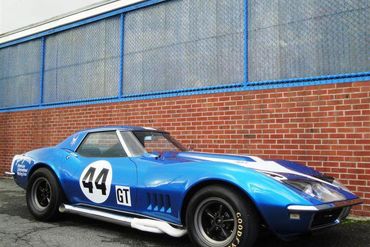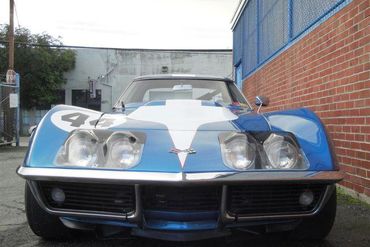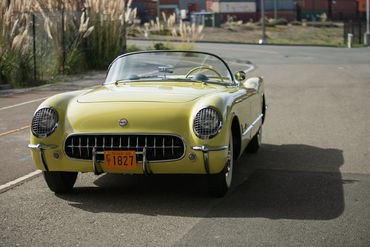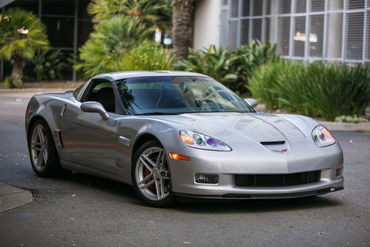Sold
SOLD 02/11
1968 Chevrolet
Corvette L88 Competition Convertible
Ex-James Garner/American International Racing (AIR)/Ed Leslie/Dick Guldstrand, 24 Hours of Daytona, FIA GT
- VIN194678S405175
- Exterior ColorBlue
- Interior ColorWhite Graphics
- Mileage4696 Miles
- Engine460 c.i. V-8
- Transmission4-Speed
- StatusSold
- StockFJ1037
Description
1968 Chevrolet Corvette L88 Competition Convertible
s/n 194678S405175
Blue with White graphics
The history of the three James Garner/American International Racing (AIR) cars is unique in automotive history, not simply because James Garner’s AIR team sponsored three cars under one banner, or because the three cars were the all-new L88s, but mostly because of the high profile role of James Garner, Hollywood movie star and car fanatic.
The Formation of AIR
As best as can be determined, the origin of the idea for American International Racing (AIR) grew out of an effort spearheaded by Bob Bondurant, Don Rabbitt (former PR man for Shelby) and Sandy Sandin. A few weeks after the 1967 Le Mans 24-Hour Race, Bondurant severely injured his foot in an accident at Watkins Glen, NY. During his convalescence, he developed a friendship with Sandin and developed the concept for the AIR team. All that was needed were some cars and some cash.
In July of 1967, James Garner and Dick Guldstrand were added as equal partners to AIR, joining Bondurant, Rabbitt and Sandin. The connection to James Garner came when Bondurant was hired to drive the camera car for the filming of the movie Grand Prix. The connection to Dick Guldstrand was likewise a result of the movie effort; he had been hired to provide technical expertise and to help Garner learn the complexities of managing a race car.
During the filming Garner had developed a strong interest in racing. In the documentary, The Making of Grand Prix he relates numerous stories of his interaction with Bondurant and Guldstrand, their off-camera racing and the general excitement of being involved in the Grand Prix scene. In their later discussions about a new racing team, it was Garner’s willingness to allow the team to use his name that resulted in a promise, on the spot, from Larry Trousdale of Goodyear to put up the necessary sponsorship funds. The concept of a three-car team using the newest high performance Corvettes was struck, then and there, at Riverside Raceway in October of 1967.
The decision to use Corvettes, however, was largely a result of history. In effect, the Guldstrand/Bondurant crew was already familiar with Corvettes from the prior year’s experience at the Le Mans 24-Hour race, so the acquisition of three L-88's was a natural. Interestingly, the three L-88's (# 45 VIN 194678S405120, # 44 VIN 194678S405175, and promotional car VIN #194678S405186) were ordered through salesman Bob Wingate, at Gledhill Chevrolet in Harbor City, CA in Herb Caplan’s name. It was Herb who put up the funds, as interim financing, until sponsor financing was finalized. Herb was also asked to participate with the team as a driver at the upcoming Daytona 24 Hour race.
The whole process was documented by David Reisner and published in GM’s Corvette News, Vol 11, No 4, 1968.
The AIR #44 car, offered here, is thus an important piece of automotive history that represents the golden era of racing. The three factory-built L-88 cars left the St. Louis plant for delivery to James Garner’s American International Racing (AIR) team in November of 1967. The three Le Mans Blue convertibles were the first production models featuring the new L-88 engine with first generation closed-chamber aluminum heads. Of course, the cars were all Central Office Production Orders (COPO)—a system which provided for an incredible range of production specifications for those with special needs. These three cars, sold to the AIR team, were effectively part of GM’s strategy to manage the release of its most powerful cars to a carefully controlled list of approved customers.
As David Reisner (the “Corvette Sleuth”) has previously reported, the cars were actually picked up at Gene Jantzen Chevrolet in St Louis. It was a GM requirement that all cars had to go through a dealer. The cars were then driven back to California in the middle of winter. The drivers were Dick Guldstrand, Bob McDonald (Herb Caplan’s crew chief) and Perry Moore (a former Caplan employee). Although delivery was recorded as being at Fred Gledhill Chevrolet, it is much more likely that the cars drove nearly directly to the first AIR shop in Culver City, just two doors down from Dick Guldstrand’s new shop.
As soon as the Garner cars were delivered, the engines were taken to Travers & Coons (TRACO) to be prepared for racing. Dick Guldstrand recalls that they had heard rumors that the DeLorenzo-Yenko team might be coming out with engines at over 600hp, maybe 650hp. They just didn’t know how to get that much power out of these new engines, but they did what they could and, one month later, they sent the cars to Daytona.
Upon arrival at Daytona, the two cars out-qualified all other FIA competition in their class. As a result, the two AIR team cars filled the front row positions for their class at the start of the race. However, as one of the most grueling endurance races, Daytona proved to be too much, and the cars were not able to keep up the qualifying pace. The # 45 car (driven by Scooter Patrick, Dave Jordan and Herb Caplan) dropped out with a blown head gasket. The # 44 car (driven by Dick Guldstrand and Ed Leslie) suffered through numerous problems with the rear differential. After changing differentials four times during the race, the team finished 29th, well down the field. The problem lay in insufficient ventilation to the differential because the team had lowered the cars as much as possible to improve performance. In an effort to improve airflow at the differential, they even tried removing the spare tire carrier. But FIA officials spotted this infraction and told them that they must run the spare tire carrier as part of the GT rules. The result was predictable.
The cars returned to Culver City and were rebuilt in anticipation of Sebring. But Don Rabbitt had already been forging plans to acquire Lolas for the balance of the season. Although the Corvettes had been pre-registered for Sebring, they never made it (Corvette News, Vol 11 No 5). The cars had run one race but would never see another race under the AIR banner. The cars were put up for sale and the AIR team ran the Sebring 12 Hour race with two Lola T70 Mk III coupes.
Ownership History:
In June 1968, a mobile home manufacturer, John Crean, bought all three Corvettes. He subsequently offered the cars for re-sale via advertisements in Competition Press. Private owners were soon found. These were Gerry Gregory (#44), Gary Neuer (#45), and Bob Wingate (promo car).
Gerry Gregory was an ex-fighter pilot recently turned racer. When the Corvette came up for sale, the race season was already well under way. Still, Gregory got a wild card entry to the ARRC runoffs at Riverside Raceway at the end of the 1968 season. During qualification, he nominally took the pole! Unfortunately, because there were no defaults in the regular entry field, he did not get to take up his wild card entry. The following year, Gregory made it to the run-offs on his own merits but DNF’d after running as high as second. Interestingly, the car still featured the AIR emblem on the hood.
At the end of the 1969 season the car went to Gene Cormany, still in its Le Mans Blue. Gene Cormany was the head of Zollner Corporation, which was the world’s largest producer of pistons, and Cormany was himself a long time SCCA racer in the Indiana district. Gene rebuilt the engine, boring it out to 460 cubic inches and installing some pistons of his own design. Gene raced the car for two years before it was passed on to his son Dave. Dave had been racing a ‘63 small block roadster through those two years, but when he wrecked that car he bought into his father’s Corvette.
In 1973 the car was purchased by Jim Herlinger. Jim had started racing in 1965 in a Porsche Speedster and then went to Formula Vee. When he first acquired the # 44 AIR car, he painted it red and added the sponsor’s “Enjoy Coca Cola” logo in white letters. As purchased, the car still had the original L-88 motor, which had been bored and stroked to 460 cubic inches.
Jim entered the season running SCCA’s “National” series, in the A-Production class. He mostly competed in his home region of San Francisco but travelled to other regions for races at Portland, Seattle, and Willow Springs. Jim took three wins that year and also ran the Bob Bondurant Corvettes-only Challenge Race at Laguna Seca.
In 1974, Jim ran one race in the newly-formed IMSA series, together with the car’s new owner, Gregg Peterson. Jim had sold the car on the understanding that he would co-drive for the longer events. Peterson had added a windshield to comply with one of the few differences between IMSA and SCCA rules. Initially, Peterson drove solo at Willow Springs, placing second in A/P. Then at the first joint race of the season, at Laguna Seca, Jim blew up the original TRACO motor. The car spun and this ended up being Jim’s last formal race. Fortunately, Jim’s brother Dave stored the blown TRACO motor (stamped TRACO 427-003) in a corner of his garage, where it remained for many years.
Dave and Jim swapped a backup motor in for the blown-up TRACO. The new engine was also based on a 454 block with aluminum heads. It was built by John Gianola and his father Bruno, owner of Reggie Jackson's High Performance Engines (otherwise known as Bruno’s Machine Shop in San Bruno, CA). Peterson went on to run two more SCCA races at Sears point and Ontario (minus the Coca Cola sponsorship) and finished the IMSA series in second place in the West Coast division.
From here, the car went to David Magaw of Tucson, AZ who ran mostly regional SCCA events in 1975. In 1976, Magaw again ran several National SCCA A/P events, but part way through the year the car was sold to Mike Alles of Grand Haven, MI. Mike also ran the 1977 SCCA season, and this was the final year of active racing.
The Restoration:
Many years later when Jim Herlinger decided he might like to get back into racing, he was skeptical about the possibility of finding his old car. It was his brother Dave who convinced him that their friend, David Reisner, could find anything. And he did. Jim made the trip to Michigan and negotiated a deal. It wasn’t a quick sale, but Jim persisted. Once home, Dave undertook the restoration of the # 44 car, at his highly regarded shop, Herlinger Corvette Repair in Mountain View, CA.
Initially, Jim did not establish a specific timeframe for the restoration so, as these things happen, the process stretched out. In fact, it took about seven years for Dave to collect all the necessary parts, cosmetically restore the engine and get the car ready for its debut. The car progressed in stages until, in 1991, it was sufficiently advanced to put the restored chassis into the National Corvette Restorer Society (NCRS) annual show…. to the surprise of many people there. Without any real thought, the whole NCRS world was about to be thrown into turmoil. The car had set in motion a chain of events that would lead to the creation of the “American Heritage” class for NCRS judging.
After this brief splash of publicity died down, the restoration slowed once more. Jim was getting a bit disillusioned by the slow progress. The problem was brought to a head when Jim had the opportunity to show the car at the Candy Store, in Burlingame, CA…if it could only be brought up to some level of completion. As far as Jim knew, the car still wasn’t ready to move under its own power, but he wanted to show if off to the other club members since the club had planned a special Corvette night and Dave McLellan was going to be on site. The car had been painted and lettered, so he pushed Dave to add the bumpers and other visible trim. Jim kept calling to see if it was going to be ready but Dave kept telling him that things weren’t going well. While Dave knew that the engine was actually ready to fire, none of the related mechanicals or wiring were installed. But Dave had a surprise planned for Jim. He figured that if he rigged a small can of gas, a fuel pump and a battery in the car, somewhere out of sight, the car could be fired.
When the evening for the party came, Dave had a twenty-four hour flu, but Steve Harrington, one of his staff at the shop, took the car over. Steve parked the car in its designated (and prominent) display area. Jim was happy enough to see the car had been well prepped, even if it wasn’t running. As the evening rolled along, Steve leaned over and told Jim…”Listen to this…”. He walked over to the car and fired it up. Everyone was taken by surprise. Of course he shut it off pretty quickly, but it had the desired effect. Jim’s interest was restored and the car was finished shortly thereafter.
Historic Racing:
After the restoration, Jim ran the car at a number of historic and concours events. The restoration is a high quality job, both in terms of historical accuracy and performance, as befits a car of this significance. Indeed, with Herlinger behind the wheel in 1999 at Sears Point, he turned 1:54 on treaded tires, compared to 1:56, which he turned in 1973 in the same car.
In total, at the end of the 2007 season the car had raced eight times and had won its class at one historic race at Laguna Seca. The car has also won trophies at the Hillsborough, Palo Alto and Monterey del Oro Concours. Guldstrand drove it at the 1999 and 2002 Monterey Historics at Laguna Seca. He has particularly enjoyed his reunions with what was, in effect, the first car he really built as a professional car builder.
Current condition and equipment:
Having received a high quality restoration and race preparation, the car has excellent race cosmetics. The paintwork was done to high standards, and while there are a few blemishes, car presents very nicely overall and would be perfectly at home on the lawn or in the paddock. The chrome and trim are in great shape, as are the light sand glass. The graphics and paint color faithfully reproduce the car’s original AIR appearance, and the car sits on vintage style Goodyear race tires and torq thrust wheels.
The interior is Spartan and purposeful, with racing buckets, roll bar, and harness. The dashboard is in great shape and is fully instrumented with warning lights and period instruments. The engine compartment is detailed and purposeful, as is the underside.
The car is very complete with three accordion folders filled with various documentation relating to the car. Included among this are three log books, various documents describing the car’s history and provenance, period photos, information about both the current and original engines, and many magazines that feature the car. Included among this is the August of 1973 issue of Playboy, in which this car was featured. Additionally, the car has FIA papers, as well as period documents from the Daytona race.
This is a unique and historic opportunity to acquire one of the three L88’s built, with fascinating and well-documented history with James Garner. This car has been beautifully restored by the best in the business, as confirmed by its FIA papers, and is widely eligible thanks to its history.
The above vehicle information is complete and accurate to the best of our knowledge at the time it is posted to this website. Corrections or additional information is always appreciated. All advertised prices exclude government fees and taxes, any finance charges, any dealer document preparation charge, and any emission testing charge. Vehicles are subject to prior sale. All advertised to be true but not guaranteed. We assume no liability for errors or omissions.
Inquire About This Car
Fantasy Junction • 510-653-7555 • 1145 Park Ave, Emeryville, CA 94608
